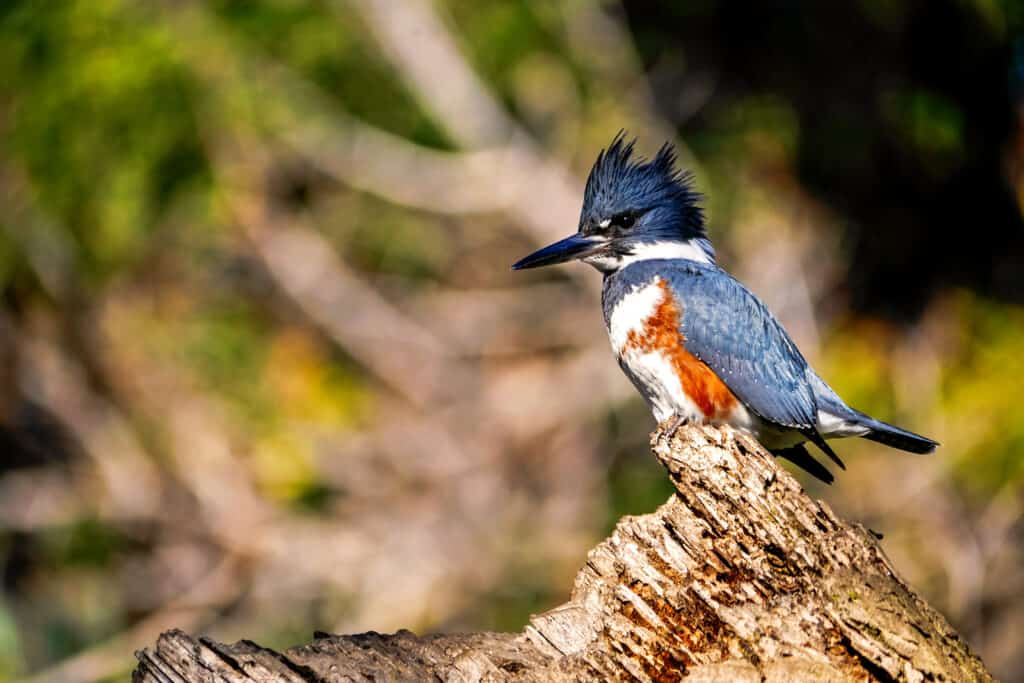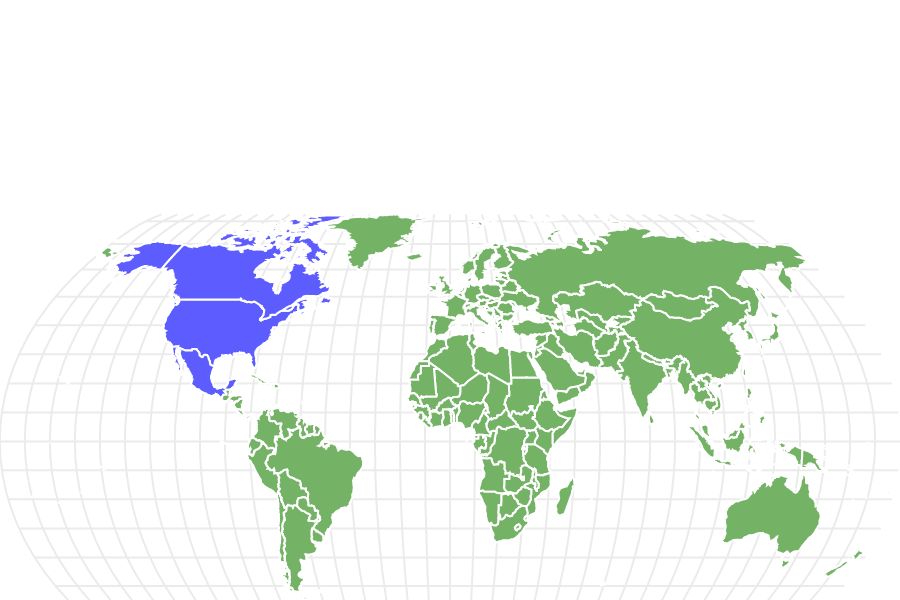Belted Kingfisher
M. alcyon
Advertisement
Belted Kingfisher Scientific Classification
- Kingdom
- Animalia
- Phylum
- Chordata
- Class
- Aves
- Order
- Coraciiformes
- Family
- Alcedinidae
- Genus
- Megaceryle
- Scientific Name
- M. alcyon
Read our Complete Guide to Classification of Animals.
Belted Kingfisher Conservation Status
Belted Kingfisher Facts
- Prey
- Fish, crustaceans, lizards, small mammals
- Name Of Young
- chicks, nestlings
- Estimated Population Size
- 1.7 million
- Distinctive Feature
- Red band on belly
- Wingspan
- 18-23 inches
View all of the Belted Kingfisher images!
“Belted kingfishers are one of the few birds to nest on the ground, where they excavate a tunnel into a sandy bank.”
The belted kingfisher is a rather large bird that is easy to spot – if you know where to look. While all kingfishers were once placed into the same family, recent research has separated them. It appears they all aren’t as closely related as their shared name implies.
3 Amazing Belted Kingfisher Facts
- Sexual dimorphism: Unlike most bird species, the female belted kingfishers have more colorful markings than the males.
- Excavators: Instead of nesting in trees, a pair of mated kingfishers will excavate a tunnel into a sandy bank at a slight uphill angle. They will nest at the end of this tunnel. They dig it uphill to create an air pocket should the tunnel flood.
- Territorial: In the mating season, these birds can become quite territorial. In some cases, they may even dive at humans.
Where to Find the Belted Kingfisher
The range of this species can be a bit confusing. Not all belted kingfishers migrate, but some of them do. There are areas where these birds stay year-round and others where they must migrate.
They will need across most bodies of water in North America. These waters can include the ocean, ponds, and lakes. They simply have to be close enough to fish.
If a bird typically lives in the northern section of its range, it will migrate to Mexico, the southern United States, Central America, and the West Indes in the winter. They cannot live where the water is frozen. Sometimes, during migration, a bird may travel far from land and end up on an island.
In the southernmost areas, some birds may migrate north in the summer. However, this doesn’t occur as frequently as birds in the northern part of the range. The southernmost point these birds are found is in Ecuador, where they may migrate every few years.
If there are remaining open bodies of water, a belted kingfisher may not migrate – even if it lives very North.
Belted Kingfisher Nests
This species has a strange nesting behavior. They do not nest in trees like other birds. Instead, they dig tunnels into the side of a river bank or sand bank. Both parents take part in this work. Once the tunnel is done, the female lays eggs, and the parents take turns incubating them.
Scientific Name
The belted kingfisher’s scientific name is Megaceryle alcyon, though it didn’t receive this whole name at once. Originally, the bird’s scientific name was Alcedo alcyon. However, it was changed in 1848.
Megaceryle comes from the words “mega” and “ceryle,” an existing genus. The term “alcyon” means “kingfisher” in Latin.
Therefore, the genus Megaceryle is simply a genus for larger kingfishers. These birds appear throughout the world and contain four different species.
The belted kingfisher’s family is Alcedinidae, commonly referred to as the kingfisher family. As you’d probably guess, this family contains kingfishers of all shapes and sizes. In total, there are 19 genera and 114 species.
Size, Appearance, & Behavior
The belted kingfisher is rather large, though it technically falls into the “medium” category as far as birds are concerned. It measures between 11-14 inches with a wingspan of 19-23 inches. It can weigh anywhere from 4.0 to 6.3 ounces. Often, the females are slightly larger than the males.
This species has a long black bill that is used for catching fish. Its large head has a shaggy crest, common in many kingfisher species.
Furthermore, this species also exhibits reverse sexual dimorphism. In other words, the females are larger and more colorful than the males – the opposite of most species. Both genders have a blue head, a blue band around their breasts, and a white collar. The back of their wings and bodies range from dark grey to slate blue.

Female belted kingfishers are identified by the orange/rust coloring. That color is absent from the male.
©Horse Crazy/Shutterstock.com
The females have another band across their upper belly that is described as orange or rust.
The juveniles are very similar to the adults. However, they all present as females until they reach sexual maturity. The red band is often mottled in juvenile males, while the band can be smaller in juvenile females.
Often, you can spot this bird perching at a high post or watchpoint close to the water. It will watch for fish from these points before diving into the water to catch them. When not hunting, the bird often flies around and makes a rattling call.
Belted Kingfisher Migration and Timing
While some birds migrate on a particular schedule, the belted kingfisher doesn’t fall into this category. Instead, only some birds migrate, usually as the water begins to freeze. If the water never completely freezes, individual birds usually don’t migrate. Birds near the coast in northern areas may never migrate if the sea remains accessible.
Of course, when a bird migrates will depend on when the water freezes in that area. Where the birds go also varies, though they seem to return to about the same point yearly. However, this varies greatly, as some individuals seem to go far out to sea and end up on islands or even in Europe.
In southern areas, belted kingfishers sometimes migrate. However, this doesn’t occur every year, and we don’t know exactly what causes them to occasionally migrate.
Belted Kingfisher Diet
The belted kingfisher gets their dinner mostly by fishing. However, they don’t just eat fish. Instead, they have slightly opportunistic feeding behaviors and tend to eat whatever is available.
What does a belted kingfisher eat?
For the most part, these birds eat fish. They will wait from a high point near the water until they spot a fish they can catch. However, these birds also eat a variety of other prey items, such as amphibians, crustaceans, insects, reptiles, and small mammals. In this way, they are slightly opportunistic.
Typically, these birds will look for food by the water. Often, this means fish. However, if another animal proves to be an easy snack, they will take the opportunity.
Predators, Threats, and Conservation Status
Currently, the belted kingfisher falls into the least concern category. There doesn’t seem to be a major decrease in their population, which currently stands at around 1.7 million individuals.
While this may seem small, these birds are territorial. Therefore, there is a limit to how many birds the land can support. Plus, they may live by the water, which further decreases where they can live despite their large range.
What east the belted kingfisher?
For the most part, belted kingfishers are only hunted by hawks. When chased by a hawk, these birds will dive into the water repeatedly until the hawk gives up. However, snakes and some mammals, such as cats, can also eat these birds.
Reproduction, Young, and Molting
After mating, a pair of belted kingfishers will dig a tunnel into the side of a bank. This tunnel is tilted slightly uphill and often quite long. While we don’t know exactly why they dig uphill, this provides an air bubble in case the tunnel floods. The chicks can stay within this air bubble and survive.
After the tunnel is done, the female lays five to eight eggs. Unlike most birds, the adults take turns sitting on the eggs and feeding the young. During this time, the birds can be extremely territorial. They will chase away predators and other birds. Sometimes, they may even chase people.
The incubation period is long, lasting between 22-24 days. Often, the nestling period is equally as long at around 27-29 days. As the babies are fed, fish bones, scales, and other debris accumulate, which helps shelter the babies more.
Population
Currently, the belted kingfisher population remains steady at around 1.7 million birds. However, extensive and recent population studies have not occurred.
RELATED ANIMALS
View all 285 animals that start with BBelted Kingfisher FAQs (Frequently Asked Questions)
Does the belted kingfisher migrate?
Yes and no. Birds in northern areas where the water freezes will migrate, as they cannot live without open water. However, birds in more southern areas do not migrate, as the water remains accessible throughout the year.
How many eggs does the belted kingfisher lay?
The belted kingfisher lays between 5 and 8 eggs in one clutch. A single breeding pair usually raises one or two sets of chicks a year.
How fast does the belted kingfisher fly?
The steady flight speed of a belted kingfisher is around 36 mph. However, they can go faster when flying from predators and diving for prey.
What is the belted kingfisher's wingspan?
A belted kingfisher’s wingspan is between 18-23 inches. Typically, females are slightly larger than males.
When do belted kingfishers leave the nest?
Nestlings will leave the nest between 27-29 days, usually. However, many continue to be under the care of their parents until they learn to fly well.
Thank you for reading! Have some feedback for us? Contact the AZ Animals editorial team.
Sources
- Wikipedia, Available here: https://en.wikipedia.org/wiki/Belted_kingfisher
- All About Birds, Available here: https://www.allaboutbirds.org/guide/Belted_Kingfisher/overview
- Audubon, Available here: https://www.audubon.org/field-guide/bird/belted-kingfisher

















